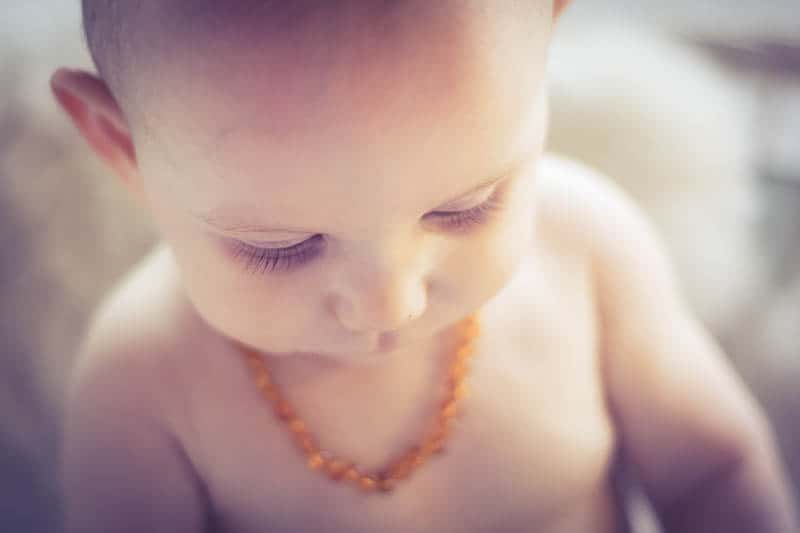Are you interested in buying an amber necklace for your baby? If your little one is teething, then I’m sure the thought has crossed your mind many times. But is this kind of jewelry safe for your baby?
Amber teething necklaces, bracelets, and anklets are not safe for babies, according to many reputable government agencies and scientists who are actively advising against their use, as they pose a strangulation risk.
At the same time, it seems like amber jewelry has never been more popular and there are numerous parents who swear by its magical healing properties.
Scientists, on the other hand, say there’s no evidence to prove that amber teething necklaces work.
Unfortunately, parents’ use of teething necklaces has already resulted in a tragic outcome when a toddler was strangled by his necklace while he was taking a nap several years ago.
Since the safety of your baby is your number one priority, I made sure to cover all the risks that come with putting an amber necklace on baby, including other useful teething tips – so read up!
What Is An Amber Teething Necklace?
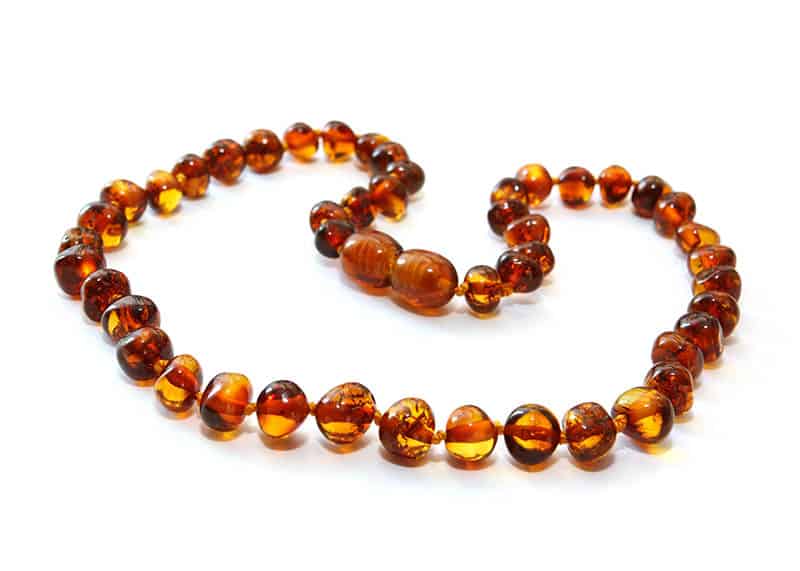
In short, an amber necklace for teething promises a quick fix during a developmental milestone that can be difficult to manage.
Teething babies, after all, are fussy, cry a lot, and are sometimes inconsolable, sending their parents into a panic where they will try anything in hopes that it will work.
Amber teething necklaces promise a natural solution to your baby’s teething pain.
They’re made from small, golden beads that are usually fashioned from Baltic amber, a fossilized tree resin – not a gemstone.
Does A Baby Amber Necklace Help With Teething Pain?
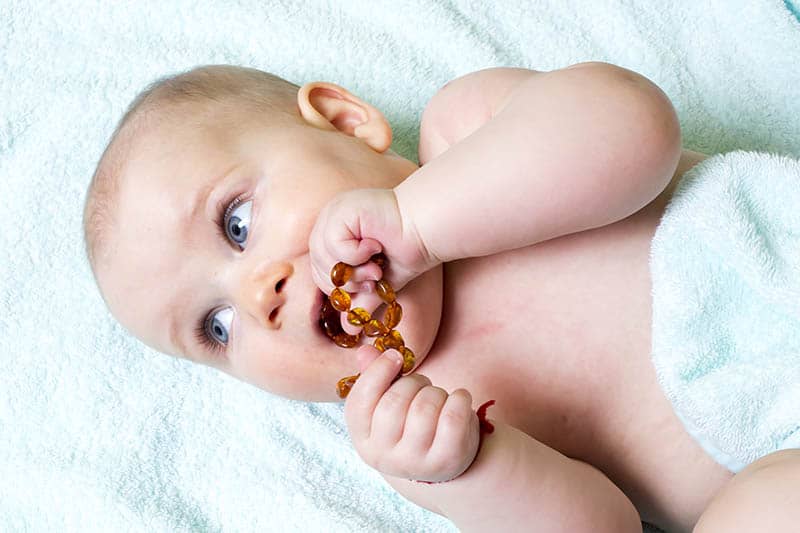
In the past couple of years, getting an amber necklace for baby has become very popular with all sorts of parents, not just those who prefer holistic remedies.
Plus, the fact that they are relatively affordable makes them accessible to most families who don’t see the harm in giving it a try – if the necklace doesn’t work, it’s not a big loss.
So, how does an amber necklace work?
Well, amber contains succinic acid which is believed to be a natural painkiller and has anti-inflammatory effects.
Some people believe that when amber beads are worn around the neck, they release this succinic acid, which is then absorbed into the skin, providing the baby with pain relief.
There are companies that even say their amber necklaces can reduce drooling.
At first, this sounds reasonable enough. However, once you factor in actual scientific data, it makes it much harder to believe that amber necklaces work.
It’s true that real Baltic amber contains succinic acid, but releasing such takes much more than simply draping the amber beads around the baby’s neck.
In order for succinic acid to be released from the beads, they would have to be exposed to a temperature of around 400 degrees Fahrenheit.
Obviously, no one could survive these high temperatures (and a baby’s body heat definitely doesn’t reach 400 degrees), so there is no scientific proof that this method of pain relief works.
Is An Amber Necklace Safe For Your Baby?

In short, no.
Both the American Academy of Pediatrics (AAP) and the U.S. Food and Drug Administration (FDA) advise against using baltic amber teething necklaces and any other amber jewelry for a very simple reason – they pose a strangulation risk.
The necklace can get twisted while the baby is sleeping or get caught on furniture, obstructing your baby’s airflow and leading to strangulation.
Unfortunately, there have been cases where babies died while sleeping with an amber necklace.
In 2016, an 18-month-old in California died while taking a nap at his daycare – he had been wearing an amber teething necklace which had gotten twisted up as he was sleeping.
Outside of the United States, there was a similar case with a 4-month-old baby in Canada, but the baby thankfully survived.
In Australia, a mom discovered that her 15-month-old daughter had somehow managed to tangle her arm inside the necklace while sleeping, causing it to wrap tightly around her neck.
Her daughter survived but only because the necklace wasn’t positioned at a point that would cause strangulation.
While countries such as Ireland released consumer product safety warnings regarding amber necklaces for babies, Switzerland and France have completely forbidden pharmacies to sell them.
On the other hand, many amber necklace for baby manufacturers say that their products are designed to be safe, with screw clasps and small beads that the baby can’t choke on.
Some companies claim that their necklaces will break open if they are caught on something so that the child doesn’t get strangled.
Whether this works or not is up for debate, as there have been scientific studies that tested this feature of amber necklaces and found that in many cases it did not work.
The 18-month-old that had died as a result of amber jewelry was also wearing a necklace with an alleged safety clasp; however, this clasp did not save his life in the end.
And if you have more than one child, a likely scenario could be that one child pulls on the necklace worn by the other, causing tragedy in mere seconds.
Remember that every company wants to sell their product and will employ marketing strategies to have you believe their amber necklace for baby is completely safe.
But at the end of the day, having anything around your child’s neck is dangerous, no matter what the promotional material says.
Amber bracelets and anklets are also dangerous as they are a choking hazard.
A baby can easily grab at the beads until they pop off and one of them could end up in his mouth, and if you’re not around to intervene, God knows what could happen.
Although there are companies that individually knot each bead so only one would come off in case the jewelry breaks, this is still one bead too many.
Then, there is another factor to consider when it comes to teething jewelry that a baby wears – bacteria.
When your baby is playing outside, his little hands are everywhere and despite your best efforts to keep those hands clean, some of the bacteria will obviously transfer to the teething bracelet, necklace, or anklet.
A 2016 study found that some baby amber necklaces were carrying the MSSA bacteria, which can cause skin infections.
You might be tempted to say, “Well, as long as I keep my eyes on my baby while she’s wearing the necklace, it will be okay.”
But the issue is that parents, despite our best efforts, aren’t 24/7 CCTV cameras. We can get distracted, forget, or look away at the wrong moment.
All in all, there are simply too many risks associated with an amber necklace for baby.
While there is no scientific proof that they are an effective method of relieving teething pain, there is plenty of evidence that they are dangerous, sometimes even at the cost of a baby’s life.
Don’t be tricked by the glowing reviews of parents who say it worked like a charm – such jewelry is still dangerous.
Unfortunately, we tend to believe that a tragic outcome won’t happen to us until it does, and just because an item is marketed as a baby product, it doesn’t mean that it’s safe.
Besides, considering the numerous alternatives to an amber necklace for baby, I don’t think it should be difficult at all to avoid them.
Alternative Teething Remedies
Without a doubt, teething symptoms are tough on both babies and parents.
Thankfully, more than ever before, parents have a wide range of remedies to choose from to help young children make it through this uncomfortable stage.
1. Teething toys

A teether is a safe toy made for babies to chew on and relieve some of the pressure they feel inside their gums.
Most are made from rubber or silicone and include a textured or bumpy surface that adds an extra kick when the baby is chewing.
This is a very safe pain reliever because it soothes sore gums without posing a serious hazard to your little one. In fact, teethers are specifically designed to be big enough to prevent choking.
Teething rings, for example, are easy for your baby to hold and gnaw on yet impossible to swallow.
You can keep them in the fridge or freezer as the cold will help with the gum inflammation. You can do the same thing with a pacifier, too.
2. A cold washcloth
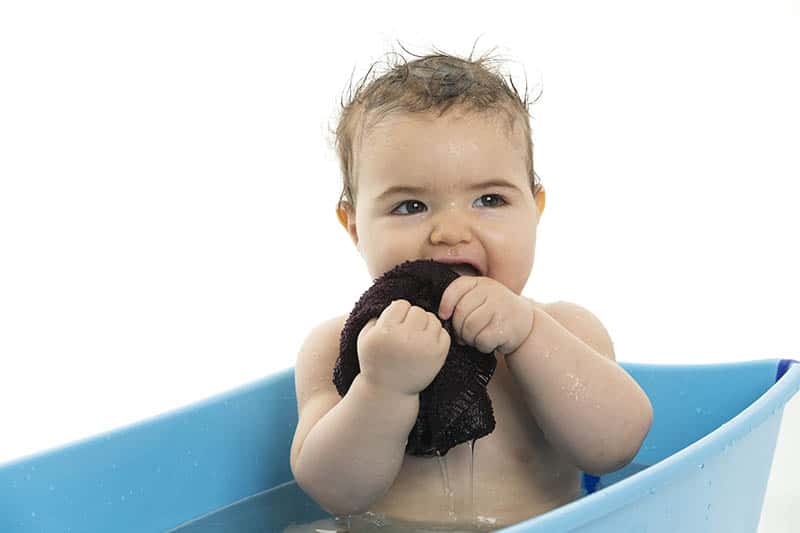
If all of your baby’s teething toys have gone missing, you can still rely on an old-fashioned washcloth to soothe your little one’s gums.
Give it a good soak in the water, wring out any excess liquid, and put the washcloth inside the freezer.
Take it out before it’s frozen solid and give it to your baby.
Washcloths are big enough to be safe for your baby and the icy sensation will numb the gums.
3. A massage
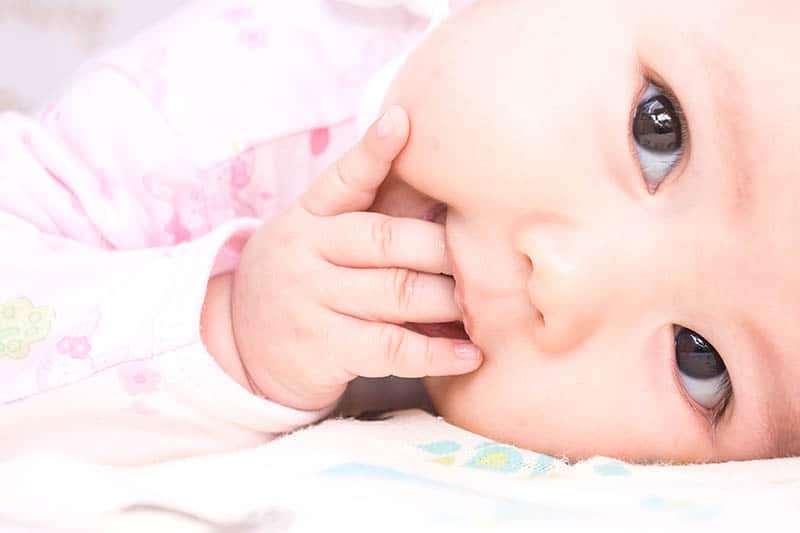
A gentle finger massage to the gums is another method you can try to make your baby feel better, just make sure to wash your hands thoroughly beforehand.
A good alternative to your finger is a baby toothbrush that contains gentle bristles – you can also keep it in the fridge prior to using it.
4. Nursing

This is an excellent tip for breastfeeding moms. Comfort nursing, or the act of offering your little one to breastfeed when he’s in distress, is a great teething remedy. And it’s all-natural, too!
When babies are teething, they’re in a lot of pain, but the affection and comfort they feel while breastfeeding can help them calm down – whether they are hungry or not.
This is especially helpful in the evening when your little one can’t settle in for the night.
5. Talk to your pediatrician about OTC pain relievers

Although OTC pain relievers such as Tylenol (acetaminophen) and Advil (ibuprofen) are available for infants, the dosages vary according to your baby’s age and weight.
Talk to your doctor about the correct dosage for your baby prior to administering either medication.
As far as age limits go, acetaminophen is safe for babies who are at least 3 months old while ibuprofen is safe for babies over the age of 6 months.
6. Mesh feeders
- Feeder helps reduce the risk of choking; Only small pieces of digestible food get through
- Simple and easy to use; Place food in mesh bag and snap shut to secure
- Colored mesh reduces staining; Introduce fresh fruits and veggies to your baby with ease
- BPA free
- 6 plus months
Prices pulled from the Amazon Product Advertising API on:
Product prices and availability are accurate as of the date/time indicated and are subject to change. Any price and availability information displayed on [relevant Amazon Site(s), as applicable] at the time of purchase will apply to the purchase of this product.
Is your little one ready for solid baby food?
Then you can get a mesh feeder and use it to give your baby some cold fruit to snack on. It doesn’t matter whether you puree it, cut it up, or mash it, as long as it’s cold!
An added bonus of mesh feeders is that your little one gets to learn how to eat independently, while the mesh material prevents him from choking on any pieces of food.
7. Chamomile tea

Chamomile is a fantastic natural remedy for sore gums. It works to soothe the inflammation and reduces pain, which makes for a much happier baby.
As long as your chamomile tea doesn’t contain any caffeine, it will be safe to use.
One of the ways in which you can apply it is to dip your finger in a cup of lukewarm tea (unsweetened) and then use it to massage the baby’s gums.
If your munchkin is old enough, offer him a few sips from an open cup.
A wet washcloth can also come in handy – simply dip it in a bit of chamomile tea and place it in the freezer until it’s cold enough.
The tea can be frozen into cubes, too, then you can put it in a mesh feeder and give it to your baby to chew on.
What about teething gels?
Prices pulled from the Amazon Product Advertising API on:
Product prices and availability are accurate as of the date/time indicated and are subject to change. Any price and availability information displayed on [relevant Amazon Site(s), as applicable] at the time of purchase will apply to the purchase of this product.
I’m sure you have already come across teething gels and creams as you did your research. One of these gels, benzocaine, is an anesthetic that’s no longer recommended to be used by kids under the age of 2.
This ingredient can be found in products such as Orajel, Anbesol, or Orabase. It puts your baby at the risk of developing a very rare condition called methemoglobinemia that can even cause death.
Even more concerning is the fact that the first symptoms of this condition can appear after several uses and you might not be aware that it’s causing harm to your baby during the first few applications.
Another ingredient to avoid is lidocaine (also an anesthetic) which should not be given to kids at all because it could result in serious injury and even death.
This is why it’s important to always check the ingredient list of every teething gel to see whether it contains one of these two anesthetics.
However, I should mention that teething gels aren’t very useful to begin with because the baby’s drool will quickly wash out any topical treatment.
Final Thoughts
When it comes to getting an amber necklace for baby, it’s easy to disregard all the potential risks as something that won’t happen to you.
And when you have an inconsolable baby in your arms, it’s understandable that you would try anything just to make your precious one feel better.
However, remember that doctors and government agencies are advising against using amber teething necklaces for a reason.
They are dangerous, have severely harmed babies, and there is no proof that they work.
In fact, in order for the amber beads to release the succinic acid and its healing properties, you would need to expose them to temperatures no human being would survive – and that’s something amber jewelry manufacturers forget to mention in their promotional materials.
Of course, no one can forbid you from getting amber jewelry for your child. But I believe every parent should be well informed on the topic and understand the risks.
In the end, the uncomfortable teething phase will be over and all the crying will be worth it once you see your munchkin’s set of pearly whites smiling up at you!
References:
“Teething Necklaces and Beads: A Caution for Parents” by the American Academy of Pediatrics, published on the Healthy Children website on December 20, 2018. Accessed September 4, 2020.
“FDA warns about safety risks of teething necklaces, bracelets to relieve teething pain or to provide sensory stimulation” by the U.S. Food and Drug Administration, published on the FDA website on December 20, 2018. Accessed September 4, 2020.
“Amber necklaces: reasons for use and awareness of risk associated with bacterial colonisation” by Pauline Machet, Philippe Lanotte, Bruno Giraudeau, Marie Leperlier, Elsa Tavernier, and Annabel Maruani published in the European Journal of Dermatology in December 2016. Accessed September 4, 2020.
Like this post? Please share or pin it for later. You can also stay in the loop and follow us on Facebook, Instagram and Pinterest.
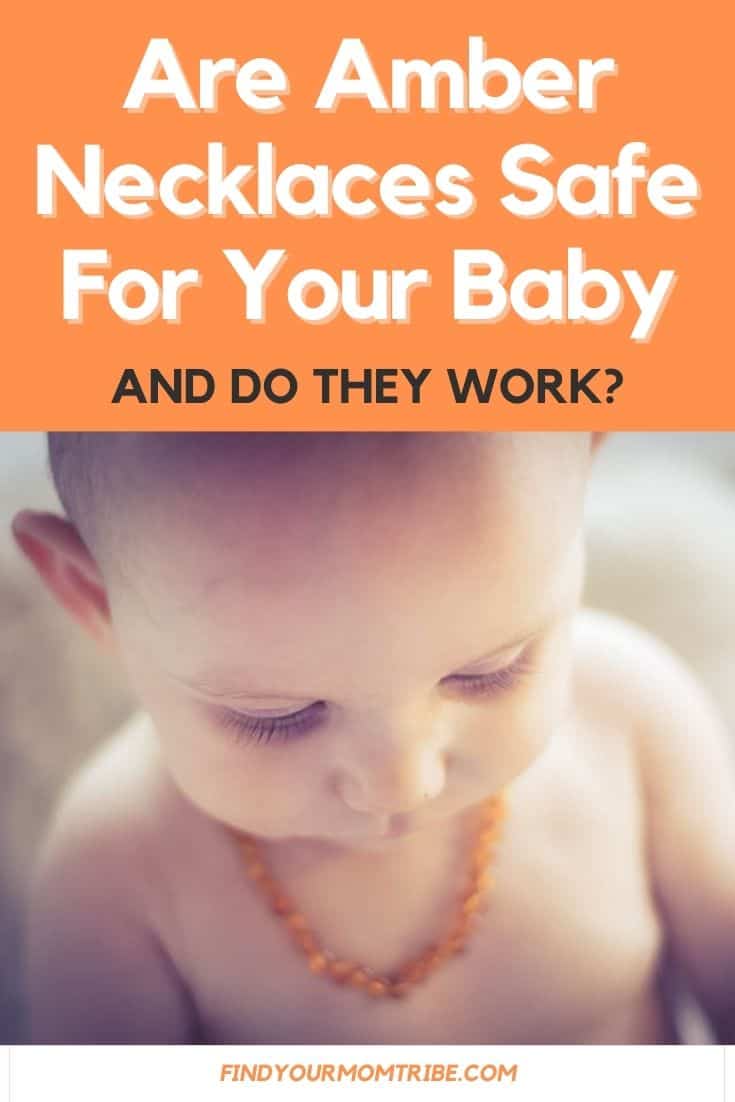
We love honesty! Find Your Mom Tribe is an Amazon Associate and we earn from qualifying purchases through affiliate links at no extra cost to you. Please see our full Amazon Affiliate disclosure for more information.

